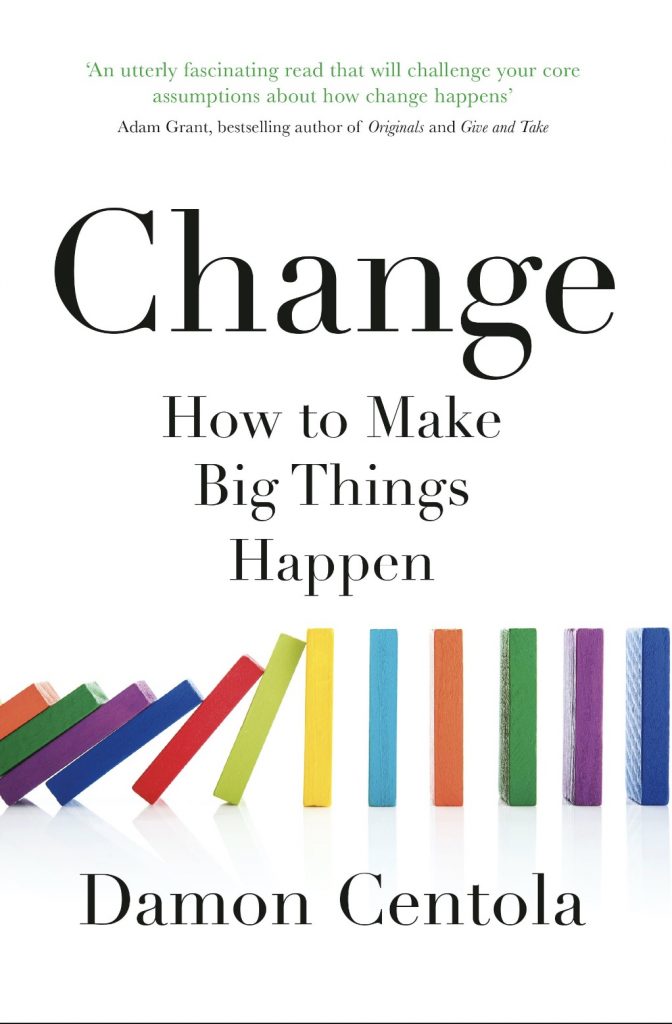Key Quote:
“Behavior change, we now understand, is not like a virus, spreading through casual contact. It does follow rules, but learning these rules takes us beyond the spread of diseases to reveal a process that is deeper, more mysterious – and much more interesting” (p. 6). — Damon Centola
Key Points
Social Networks Are the Key. Centola argues that the key to making change happen is focusing on the power of social networks. Different types of networks (e.g., dense or sparse, clustered or dispersed) can profoundly affect the spread of ideas and behaviors. Traditional methods of organizing groups, such as top-down hierarchical structures, are often ineffective in creating lasting change.
Debunking Myths. The power of status, a “simple contagion” concept, and “stickiness” – these approaches are all overrated as effective methods for social change.
Simple vs. Complex Contagions. For widespread change, an idea should be modeled and adopted by a group (rather than a single influencer) and shared through weaker ties across “wide bridges” by multiple peers.
The “Snowball” Strategy. One efficient way to enact change – but which does require some time commitment – is to grow a “critical mass” of people to adopt a social change, focusing on a small group of change agents who know each other and can reinforce each other. These influence each other and then their own social network. The new idea gains traction and then has the strength to spread through weak ties to other groups. It is “group” and “place” focused, versus “individual” focused.
Fundamental Strategies for Change. Centola lists seven key strategies for change, including using weak ties to bridge social circles, protecting early adopters from facing too much opposition, using your network “periphery” instead of influencers to bring about change, and using team networks to improve discovery and reduce bias.
Myths for How Social Change Happens
Influencers (celebrities, national figures, and thought leaders) will not spread ideas through their status alone. “When it comes to social change, the myth of the influencer obscures real pathways that have led challenging and even controversial social, commercial, and political initiatives to succeed. The first step in seeing how change really works is to stop looking for the special people in the network and instead start looking for the special places” (p. 27). Any one person’s influence is only effective if there is a collection of people, a social network of nameless people, also invested and joining in the change. People join a movement because other people like them join a movement.
Contagion (i.e., information spreading) does not occur most effectively via strong ties or tightly knit social circles. Instead, weaker ties are more effective, generating a more expansive reach without continual redundancy of membership. “Even if the message is intuitive and ‘sticky’. . . if it spreads solely through strong ties it will end up ricocheting around the same community of people without traveling very far” (p. 42). Someone new – someone on the edge – has to hear it and spread it.
“Stickiness” does not always allow for effective social change, especially if individuals are unable to identify with the appeal of the idea. In fact, “catchy advertising, aggressive marketing, and impressive science are often not enough to change people’s beliefs and behaviors. Cultural and social norms embedded in our networks can create enduring opposition to change” (pp. 59-60).
Simple vs. Complex Contagions
Simple contagions, like a virus or gossip, spread easily from one person to another and benefit from broad social networks (p. 81).
Complex contagions pertain to the deeper process of social spreading and how audiences respond to innovation. They are contagions that people often resist until multiple adopters supply reinforcement or social proof, and they eventually become persuaded to adopt the new idea or behavior (p. 82).
Barriers to the adoption of complex contagions include difficulties with coordination, credibility, legitimacy, and excitement – but social reinforcement can overcome these barriers (pp. 82-84).
Case Study – Black Lives Matter
The “Black Lives Matter (BLM)” movement is an example of complex contagion, gaining legitimacy only in 2015, even though the hashtag #BlackLivesMatter had been in use since about 2012 (p. 127).
It was in 2015 when the groups in conversation about BLM truly started communicating with each other, demonstrating Centola’s concept of “wide bridges.” These exist when selected change agents share common contacts and spread information through these channels.
By the time of George Floyd’s murder in May 2020, the vast network of wide bridges already created by the BLM movement was able to spread and transform public outrage into the most widespread solidarity campaign in history (p. 136).
The Principles of Relevance
Principle 1: “When people need social proof that a particular innovation will be useful for them, then similarity with earlier adopters is a key factor for creating relevance” (p. 141).
Principle 2: “When behavior change requires a degree of emotional excitement, or feelings of loyalty and solidarity, then — once again — similarity among the sources of reinforcement will help to inspire behavior change” (p. 141).
Principle 3: “When behavior change is based on legitimacy — that is, believing that the behavior is widely accepted — then the opposite is true: diversity among reinforcing sources of adoption is key for spreading the innovation” (p. 141).
On Social Norms
Social norms serve an important function in solving a “coordination dilemma.” Within a culture, people coordinate when navigating down a road, for example, reflexively understanding the driving side of the road. We all already know what “the other guy” will do.
These norms are more like reflexes. We consider them “natural” without considering the alternatives. This is useful in everyday circumstances. “Often we don’t notice our norms until we travel to a new place where the norms differ” (p. 170).
Challenges of Changing Social Norms
Changing a social norm is difficult. “For social change to succeed, a revolutionary movement must ferry people across these uncertain waters to a new set of expectations and a new sense of competence. The secret to doing this successfully comes from seeing how language works, and what it reveals about how social norms take hold” (p. 175).
It requires breaking something that works. It requires replacing something familiar and natural with something new and foreign.
When social norms change, we transform from experts into novices. The familiar ways of talking and thinking suddenly become obsolete. Years of work are instantly irrelevant (p. 171).
Wittgenstein’s Coordination Games
Philosopher Ludwig Wittgenstein developed a theory of language which he then radically upended, altering the course of philosophy. He “continued to believe that language was the key to understanding the world. But he no longer believed that logic was the key to understanding language. Rather, language was social. The secret to understanding language was to understand how people play coordination ‘games’ with one another” (p. 176).
Wittgenstein’s conception of social life as a series of coordination games has become a general tenet for research on social norms.
The Tipping Point of Social Change
The tipping point is “the point at which a novel behavior gained enough traction that everyone’s opinion about what was acceptable would suddenly change” (p. 179). Centola stresses, “our need for social coordination is more powerful than our love of tradition — and that that need was the key to social change” (p. 185).
Three core tipping point strategies.
There are three approaches commonly used to bring about social change. The third one – the “snowball” strategy – is shown to be very effective.
1. The “shotgun” strategy is based on the principle of viral marketing. Resources distribute broadly, like a shotgun, and “change agents” strategically spread information throughout networks (p. 210).
2. The “silver bullet” strategy, also known as the influencer strategy, finds the most connected person and concentrates all resources on this target (p. 213).
3. The “snowball” strategy is a particularly effective approach based on targeting special places
in the social network where people are geographically close. In time, given the level of connectedness amongst the group, they are most likely to adopt an idea or change with high trust.
Case Study – Agricultural Practices in Malawi and the “Snowball Strategy”
A 2010 study in Malawi produced key insights derived from the implementation of a change in crop planting techniques to a more sustainable and higher-yielding approach over a four-year period.
The best-performing change mechanism was the snowball strategy, which relied not on physical proximity but on network architecture. The snowball-neighborhood strategy (a hybrid of the winning snowball strategy) was the second best-performing, while the default shotgun strategy finished last (p. 224).
“The snowball strategy targeted change agents with shared contacts in common. Each of these contacts would observe two of their peers adopting pit planting. This made them more willing to learn about the new technique” (p. 225).
“That’s the power of a snowball. Just a little social reinforcement can grow into something much larger. And more reinforcement can make it go even faster” (p. 225).
Seven Strategies for Change
Centola’s seven rules for promoting change pertain to “propagating norms” rather than “spreading information.”
1. Do not rely on (viral) contagiousness. Instead, weaker ties between loosely connected individuals with lower levels of interaction are more effective because they create more redundancy. Weak ties can be particularly effective for spreading ideas or behaviors because they can bridge different social circles and create new connections.
2. Protect the innovators. Early adopters in the network periphery can better reinforce one another without facing overwhelming opposition from countervailing influencers. Innovations facing entrenched opposition can be effective if the innovators have less exposure to the network.
3. Use the network periphery (rather than influential people). They are more likely to be pioneers of social innovations than so-called social influencers are. They are also more likely to be less connected, and, therefore, less likely to be overcome by countervailing influencers (which tend to focus on countering highly connected members of the network).
4. Establish wide (and redundant) bridges. Wide bridges across groups help learning and mutual understanding, but only when these interactions can make diverse participants feel relevant to each other.
5. Create relevance using the “three principles of relevance” (described above).
6. Use the snowball strategy to target bridging groups on the community boundaries. As shown by the Malawi case study, the snowball effect tends to be most effective at ensuring the successful adoption of ideas with high trust, although this typically takes place over a longer period.
7.Design and use team networks. Protect innovators and early adopters by designing team networks to both improve discovery and reduce bias and influences that reinforce the status quo.
Centola, D. (2021) Change: How to Make Big Things Happen. New York: Little, Brown Spark.

“Behavior change, we now understand, is not like a virus, spreading through casual contact. It does follow rules, but learning these rules takes us beyond the spread of diseases to reveal a process that is deeper, more mysterious – and much more interesting.”
“The snowball strategy targeted change agents with shared contacts in common. Each of these contacts would observe two of their peers adopting pit planting. This made them more willing to learn
about the new technique.”
